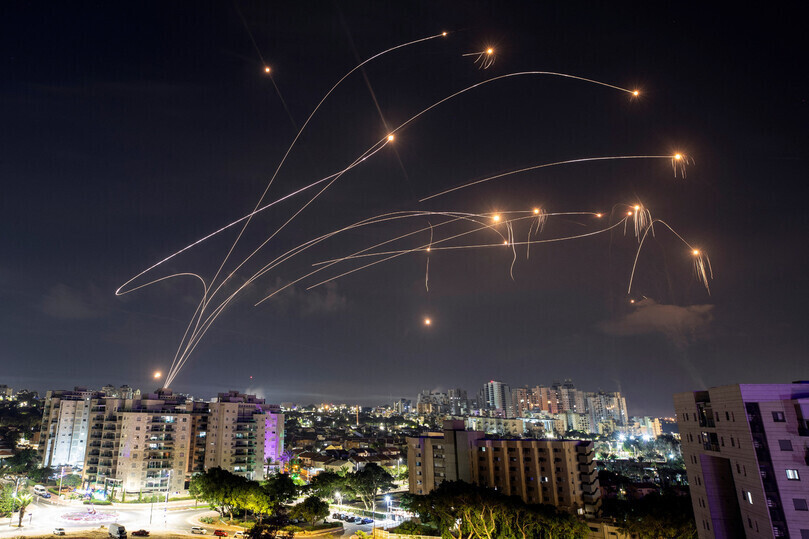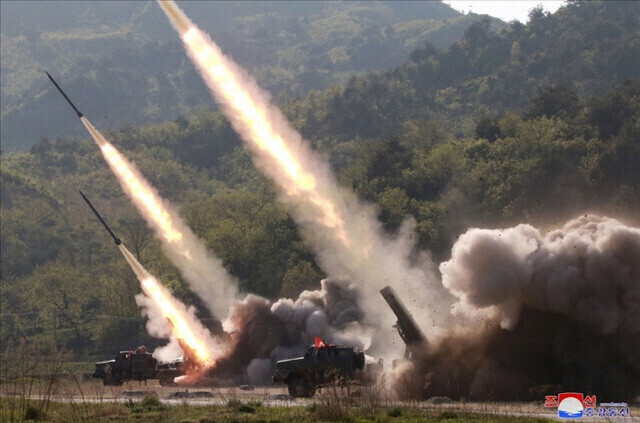hankyoreh
Links to other country sites 다른 나라 사이트 링크
$600 rockets shatter Israel’s Iron Dome – will Seoul’s skies be safe?

On Saturday, Hamas, the militant group that controls the Palestinian territory of Gaza, launched a major offensive against Israel.
Many of the rockets fired by Hamas penetrated Israel’s low-altitude air defense system, known as the Iron Dome, and struck Israel.
The Iron Dome is a weapon system that intercepts short-range rockets and artillery shells within a range of 4 to 70 kilometers at an intercept altitude of 10 kilometers.
During previous armed conflicts between Israel and Hamas, Israel’s Ministry of Defense has released videos showing how the Iron Dome intercepts rockets fired by Hamas, the scenes bearing a resemblance to fireworks bursting in the sky.
Since the deployment of the Iron Dome in 2011, Israel has claimed to have intercepted more than 90% of Palestinian rockets fired from Gaza. These claims have given rise to the myth of the Iron Dome’s invincibility.
In South Korea, there have been calls for a version of the tried-and-tested Iron Dome to be introduced domestically in response to high levels of public anxiety over North Korea’s long-range artillery.
In fact, the military considered introducing an Iron Dome after the shelling of Yeonpyeong Island in November 2010. However, it was rejected for being “not suitable for the terrain and battlefield environment of the Korean Peninsula.” The reasoning was that there was too vast of a difference between Hamas, a poorly armed militant group, and the North Korean military, which has the ability to launch rockets in large numbers.
In an armed clash in May 2021, Hamas reportedly fired 4,300 rockets in the span of 10 days — that makes for 430 rockets per day, or 18 rockets per hour. North Korea’s long-range artillery is reportedly capable of firing 16,000 rounds per hour. Put differently, if Hamas rockets are a drizzle, North Korea’s are a downpour.
A missile defense system like Israel’s Iron Dome would prove woefully inadequate to defend against a barrage of North Korean artillery shells targeting the Seoul metropolitan area. A single battery for the system is said to be able to intercept 30 rockets, and costs around US$50 million.
South Korea would need an inordinate amount of batteries to defend against a North Korean long-range artillery attack, so much that it would cost more than 3 trillion won (around US$2 billion). For this reason, it was deemed not suitable for the battlefield environment on the Korean Peninsula.
Hamas has been firing rockets intermittently, but released a barrage of rockets during this most recent offensive. On Saturday, Mohammed Deif, who heads the military wing of Hamas, claimed in a statement that the group had fired more than 5,000 rockets in the first 20 minutes of their strike — that makes for a rate of 15,000 per hour.

Like North Korean long-range artillery could on Seoul, the massive barrage of rockets rained down on Israel, exceeding the ability of Israel’s 13 or so Iron Dome batteries to respond.
The Iron Dome system was likely overloaded, prompting radar and fire control systems to fail, and interceptor missiles to be depleted in no time. The lesson is not that this most recent offensive was a miraculous breach of Israel’s impenetrable Iron Dome, but that the Iron Dome was never the perfect ironclad system many claimed it was in the first place.
In 2020, the South Korean Ministry of National Defense made the decision to proceed with developing a “Korean-style Iron Dome” system to intercept North Korean long-range artillery. The Yoon Suk-yeol administration announced in July 2022 that it planned to move the timeline for its integration up from 2030 to 2026.
Many South Koreans hope that once the Korean-style Iron Dome is complete, the greater Seoul area will be safer from the threat of North Korean long-range artillery. The reality, however, is that even with such a system, it is impossible to completely block a North Korean rocket attack.
It is disadvantageous to South Korea to adopt an approach of beefing up defense capabilities that focuses on trying to keep pace with North Korea’s missile and long-range artillery threats. Even if it invests massive amounts of money in networks for missile defense and long-range artillery interception, the North can respond by increasing its stockpiles of missiles and artillery — which is much less pricey — and by using multiple or decoy warheads or mixing missile strikes with artillery strikes.
The biggest problem with South Korea acquiring the capabilities to intercept North Korean missiles and long-range artillery is the low cost-effectiveness.
As the current clash between Israel and Hamas shows, it could run into a situation where the defending side swiftly runs out of expensive interception missiles as the attacking side launches large amounts of cheap rockets all at once.
One interception missile used for Israel’s Iron Dome costs the equivalent of around US$60,000 while one Hamas rocket costs a hundred times less, at about US$600.
What the Israel-Hamas conflict shows is that it is impossible to intercept massive amounts of rockets that are all launched in a short span of time.
This is where South Korean authorities should explain that the North Korean long-range artillery interception system it is developing is not meant as an ironclad defense for the greater Seoul region as a whole — but will be selectively focusing on certain key facilities, including the presidential office, armed forces command, airfields and ports.
By Kwon Hyuk-chul, staff reporter
Please direct questions or comments to [english@hani.co.kr]

Editorial・opinion
![[Column] When ‘fairness’ means hate and violence [Column] When ‘fairness’ means hate and violence](https://flexible.img.hani.co.kr/flexible/normal/500/300/imgdb/original/2024/0516/7417158465908824.jpg) [Column] When ‘fairness’ means hate and violence
[Column] When ‘fairness’ means hate and violence![[Editorial] Yoon must stop abusing authority to shield himself from investigation [Editorial] Yoon must stop abusing authority to shield himself from investigation](https://flexible.img.hani.co.kr/flexible/normal/500/300/imgdb/original/2024/0516/4417158464854198.jpg) [Editorial] Yoon must stop abusing authority to shield himself from investigation
[Editorial] Yoon must stop abusing authority to shield himself from investigation- [Column] US troop withdrawal from Korea could be the Acheson Line all over
- [Column] How to win back readers who’ve turned to YouTube for news
- [Column] Welcome to the president’s pity party
- [Editorial] Korea must respond firmly to Japan’s attempt to usurp Line
- [Editorial] Transfers of prosecutors investigating Korea’s first lady send chilling message
- [Column] Will Seoul’s ties with Moscow really recover on their own?
- [Column] Samsung’s ‘lost decade’ and Lee Jae-yong’s mismatched chopsticks
- [Correspondent’s column] The real reason the US is worried about Chinese ‘overcapacity’
Most viewed articles
- 1Could Korea’s Naver lose control of Line to Japan?
- 2[Column] Welcome to the president’s pity party
- 3[Column] US troop withdrawal from Korea could be the Acheson Line all over
- 4Naver’s union calls for action from government over possible Japanese buyout of Line
- 5[Editorial] Korea must respond firmly to Japan’s attempt to usurp Line
- 6Korea cedes No. 1 spot in overall shipbuilding competitiveness to China
- 7[Editorial] Yoon must stop abusing authority to shield himself from investigation
- 8[Column] When ‘fairness’ means hate and violence
- 9Korean opposition decries Line affair as price of Yoon’s ‘degrading’ diplomacy toward Japan
- 10Second suspect nabbed for gruesome murder of Korean in Thailand, 1 remains at large